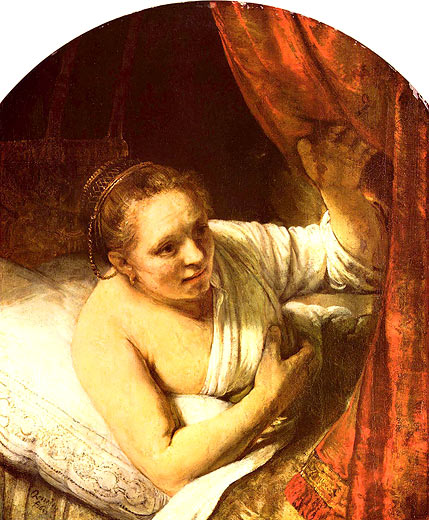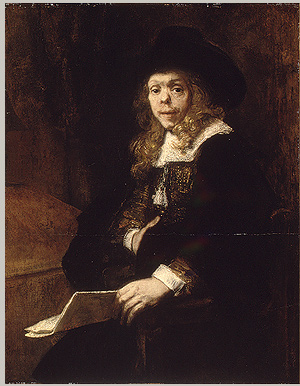Rembrandt. He was happily married and had one son. He was financially prosperous and creatively vigorous. But to a man of Rembrandt’s nature, prosperity and public adulation paled in comparison to finding solutions of problems in painting and new ways to express his philosophical ideas through the medium of his art.
Rembrandt’s loss of his wife and his first three children certainly contributed to an introspective moodiness of his work that seemed to replace the spirit of profound joy that permeated his work up to “The Night Watch” in 1642. He began to no longer bother painting in accord with popular taste, and was also unwilling to modify his work to regain popularity, apparently, dropping out of the system and into professional obscurity and very humble quarters.

—Instead his paintings become broader in handling and more intimate in feeling and scale. A perfect example of this is the so-called Hendrickje Stoffels in Bed in the Edinburgh Gallery, where the artist has concentrated on the mood of a woman who has just woken from a deep sleep.—click image for source…
The concept of an artist creating for himself is a product of modernism, but in Rembrandt’s century it was exceptional for an artist to regard his work centrally as a personal experience, and only secondly as a public offering. In these later years, Rembrandt pondered the relation of the human soul to the circumstance of human existence, its relation to God, the reconciliation with the physical world, and all life’s accidents and imperfections with the conviction that life is justified by some cosmic good, even though it may be beyond our intelligence to understand it.

—Gerard de Lairesse (1641–1711) was, in his day, a well-known painter, etcher, and art theorist. He suffered from congenital syphilis, which caused him to go blind about 1690; he subsequently focused his energies on art theory. By the time this portrait was painted, around 1665, the ravaging effects of the disease were visible in his swollen features and bulbous nose. Recording his unfortunate appearance with an uncompromising directness, Rembrandt invested his subject with an air of quiet dignity.—click image for source…
Rembrandt’s image of the world are seldom beautiful in themselves, since the models are often homely and battered, subject to all the chance, misfortune and indignity of suffering that is part of daily life. But these figure are transcended beyond mere objectivity by being invested with a spiritual majesty concording with his idea of the ultimate nobility of the human being in spite of of horrendous experience. In the end, since it is an affirmation of good, Rembrandt’s art remains joyous.





 COMMENTS
COMMENTS